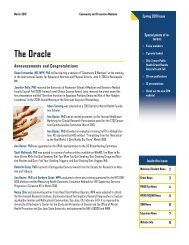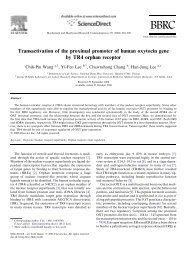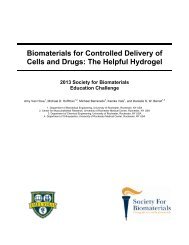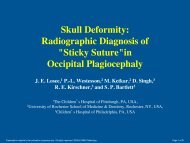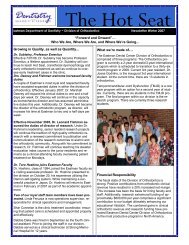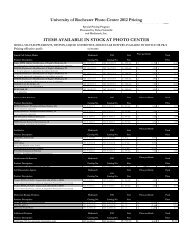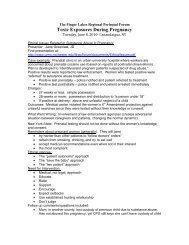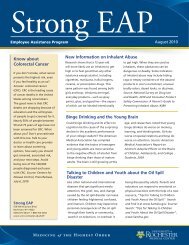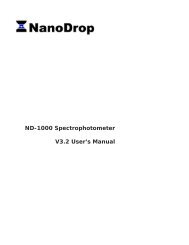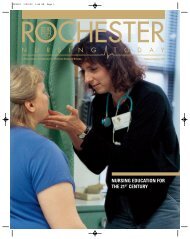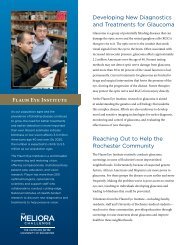Healthy Signs - University of Rochester Medical Center
Healthy Signs - University of Rochester Medical Center
Healthy Signs - University of Rochester Medical Center
You also want an ePaper? Increase the reach of your titles
YUMPU automatically turns print PDFs into web optimized ePapers that Google loves.
<strong>Healthy</strong> <strong>Signs</strong><br />
National <strong>Center</strong> for Deaf Health Research May 2013<br />
DHCC<br />
Finger Lakes Deaf Health Fair - A<br />
Summary and Recap<br />
HL2<br />
Walk4Hearing - HLAA helping those<br />
with hearing loss<br />
Other Community<br />
Engagements<br />
Upcoming Events!<br />
NCDHR<br />
HAPPENINGS<br />
Matt Starr Lectures at St. John Fisher<br />
College<br />
Deaf Mothers’ Outreach in Support<br />
<strong>of</strong> Breastfeeding - The production<br />
<strong>of</strong> Vlogs<br />
2013 <strong>University</strong> <strong>of</strong> <strong>Rochester</strong> Diversity<br />
Conference - Our Differences Our<br />
Strength<br />
Where are<br />
they now<br />
Susan Demers-McLetchie<br />
NCDHR<br />
Retreat 2013<br />
Summary<br />
Making plans to submit its<br />
third 5-year funding grant<br />
application
<strong>Healthy</strong> <strong>Signs</strong> May 2013<br />
NCDHR Retreat 2013 Summary<br />
Making plans to submit its third 5-year funding grant application<br />
As the second 5-year Prevention Research <strong>Center</strong>s (PRC) funding is approaching its last year (October 2014), our<br />
center and its community partners are gearing up for a busy time to apply for its third funding cycle. It’s expected that<br />
the 2014-2019 PRC application (called “Funding Opportunity Announcement” or “FOA”) will be released sometime this<br />
summer, with a submission due date a couple <strong>of</strong> months later. Typically, universities would delegate some <strong>of</strong> its faculty<br />
to write the grant application, which sometimes can be hundreds <strong>of</strong> pages long! However, the PRC’s FOA requires<br />
an university to demonstrate clear evidence <strong>of</strong> collaboration with its community partners. The centerpiece <strong>of</strong> the PRC<br />
program is “Community-Based Participatory Research (CBPR).” The definition <strong>of</strong> CBPR is:<br />
“A collaborative process <strong>of</strong> research that involve researchers and community<br />
partners in all phases <strong>of</strong> research.”<br />
Preparing for a new public health research grant application is considered an important phase <strong>of</strong> research. This<br />
preparation involves:<br />
Analyzing past and current health data<br />
Identifying health priorities<br />
Determining the feasibility <strong>of</strong> proposed research ideas<br />
And much more<br />
It also requires the involvement <strong>of</strong> both researchers and community partners – just as in the above highlighted part<br />
<strong>of</strong> the definition.<br />
Our center is interested in learning what our community members, who are considered “experts” in their everyday<br />
life experiences, think about which issues would have the greatest community health benefit(s) for their communities.<br />
Our <strong>Rochester</strong> PRC (NCDHR) has successfully secured 5-year funding grants in 2004 (to develop an ASL-based Deaf<br />
Health Survey) and in 2009 (to study a randomized clinical trial <strong>of</strong> a healthy<br />
lifestyle intervention called “Deaf Weight Wise”). As for the 3rd funding<br />
cycle, how can both researchers and community partners decide what the<br />
core research project should be The process <strong>of</strong> narrowing down numerous<br />
issues into a prioritized “research core project” is a major undertaking, and<br />
this process has just begun with the first center-wide retreat last month.<br />
How can both researchers<br />
and community partners<br />
decide what the core<br />
research project should be<br />
Continued on next page<br />
Front Page<br />
Page 2
<strong>Healthy</strong> <strong>Signs</strong> May 2013<br />
Dr. Thomas Pearson<br />
Director NCDHR<br />
Val Nelson-Metlay<br />
Chair DHCC<br />
Mary Chizuk<br />
Co-Chair HL2<br />
Don Bataille<br />
Co-Chair HL2<br />
Dr. Jim DeCaro<br />
Chair LPAB<br />
Matt Starr<br />
Administrator NCDHR<br />
Nearly 40 researchers and community partners met during the evening at the Saunders Research Building on April 3.<br />
An agenda and communication, participation & courtesy ground rules were distributed. Retreat participants enjoyed<br />
dinner during introductions to staff and volunteers announced by chairs <strong>of</strong> various committees: Dr. Thomas Pearson<br />
for NCDHR, Valerie Nelson-Metlay for the Deaf Health Community Committee (DHCC), Mary Chizuk and Don Bataille<br />
for the <strong>Healthy</strong> Living with Hearing Loss (HL2), Dr. Jim DeCaro for the Local Partner Advisory Board (LPAB) and Matt<br />
Starr for other partners such as NCDHR’s Community Partner Staff.<br />
After the introductions, Dr. Pearson gave an engaging presentation<br />
about NCDHR past and current accomplishments in five significant<br />
center components: infrastructure, research, community partnerships,<br />
communication & dissemination, and education & training.<br />
Then, Drs. Jim DeCaro and Scot Atkins, both from NTID, served as effective<br />
facilitators for further discussions on three questions:(1) How are we doing,<br />
(2) What should the next step be, and (3) Who else should be involved<br />
Numerous comments were recorded from the retreat<br />
participants. Click here to see the summaries <strong>of</strong> the<br />
retreat comments. Many thanks to Jim and Scot for<br />
a job well-done in engaging and facilitating retreat<br />
participants’ thoughts and comments!<br />
To see the PowerPoint presentation from Dr.<br />
Thomas Pearson during the retreat, click on the<br />
image above.<br />
In closing, Dr. Pearson wrapped up by explaining the timeline for this year’s FOA process.<br />
Matthew Starr, Administrator and Community Liaison with the <strong>Rochester</strong> PRC, will be working<br />
Dr. Scot Atkins<br />
closely with leaders from all community partners to plan and organize town hall meetings, within<br />
the next two months. These meetings will be open to the Deaf community as well as to the<br />
community <strong>of</strong> people with hearing loss.<br />
Stay tuned!<br />
Front Page<br />
No one should be left out during any<br />
community-based deliberations on what<br />
should be the most important community<br />
health issue or issues, especially for Deaf<br />
ASL users and people with hearing loss!<br />
Page 3
<strong>Healthy</strong> <strong>Signs</strong> May 2013<br />
DHCC<br />
Finger Lakes Deaf Health Fair<br />
A summary and recap<br />
HL2<br />
Other Community<br />
Engagements<br />
NCDHR<br />
HAPPENINGS<br />
As part <strong>of</strong> the Health<br />
Engagement and Action for<br />
Where are<br />
<strong>Rochester</strong>’s Transformation<br />
(HEART) initiatives, NCDHR<br />
they now also promoted the Deaf Farm<br />
Stand, which will resume again<br />
in July at the <strong>Rochester</strong> Recreation Club for the Deaf. NCDHR was successful in<br />
recruiting 14 community members to be a part <strong>of</strong> this project as volunteers.<br />
The Finger Lakes Deaf Health Fair brought both new and familiar faces to<br />
NCDHR’s table. Some who have been a part <strong>of</strong> NCDHR’s research since it<br />
began, and some out <strong>of</strong> town or out <strong>of</strong> state individuals who were not familiar with<br />
NCDHR but were eager to learn more about Deaf Health Research. Roughly 65<br />
people approached the NCDHR table to learn more.<br />
During the entire day’s events, more than 200 attendees participated in the<br />
Finger Lakes Deaf Health Fair. Many people remarked that it was an enriching<br />
experience in learning about Deaf culture, its language, American Sign Language<br />
(ASL), blended with healthcare and healthy lifestyle education.<br />
On April 20th, the Deaf Health Community Committee (DHCC) held<br />
their first Finger Lakes Deaf Health Fair at the <strong>Rochester</strong> School for<br />
the Deaf. NCDHR was thrilled to be a part <strong>of</strong> this event, providing an<br />
exhibit table with information related to current and upcoming research<br />
events.<br />
NCDHR staff provided information about the upcoming Deaf Health<br />
Survey 2013 and also had our recruitment video on display, explaining<br />
why the Deaf Health Survey is being held again and the importance <strong>of</strong><br />
the community involvement with research.<br />
Of course, the success <strong>of</strong> the health fair would not be possible without the participation <strong>of</strong> the health fair partners,<br />
including over 20 health-related organizations and the <strong>Rochester</strong> School for the Deaf. Additionally, Genesee Valley<br />
Region Registry <strong>of</strong> Interpreters for the Deaf (GVRRID) was a co-sponsor <strong>of</strong> the event.<br />
If you have any afterthoughts on how the Finger Lakes Deaf Health Fair Planning Committee can even do better for<br />
the next Deaf Health Fair, please do not hesitate to contact them at: FLDeafHealthFair@gmail.com.<br />
Front Page<br />
Page 4
<strong>Healthy</strong> <strong>Signs</strong><br />
May 2013<br />
DHCC<br />
HL2<br />
Other Community<br />
Engagements<br />
NCDHR<br />
HAPPENINGS<br />
Where are<br />
they now<br />
Walk4Hearing<br />
HLAA - Helping those with Hearing Loss<br />
By David Koon<br />
Article from the Genesee Valley Penny Saver<br />
Did you know that more than<br />
36 million people in the US have<br />
a hearing loss which can hinder<br />
daily communication By age<br />
65, one in three Americans has<br />
a hearing loss. When hearing<br />
loss occurs suddenly there is no<br />
denying it; the world and your<br />
life change immediately. When<br />
hearing loss occurs over years,<br />
Photos provided by Arthur Maurer<br />
David Koon, 2013 Walk Chairperson, and<br />
Sue Miller, 2012 Chairperson<br />
the changes in your life are not as clear-cut. It’s easier to tell yourself<br />
it’s not really your hearing, it’s that people “mumble” or are “talking too<br />
fast,” or “I was distracted, so I missed what you said.”<br />
Admitting you have a hearing loss is the first step; having your<br />
hearing tested by your doctor or an audiologist is the next. People<br />
respond differently to the news that their hearing loss is real and they need help, usually by the use <strong>of</strong> hearing aids.<br />
If your hearing loss is mild, the transition may be relatively easy; if it’s severe, the adjustment may take longer. Once<br />
your hearing loss is confirmed you may feel vulnerable or depressed. Rest assured you are not alone. Everyone with<br />
hearing loss has experienced various degrees <strong>of</strong> anxiety and uncertainty. As you gain knowledge and experience<br />
you will gain courage and confidence. You’ll learn to enjoy life despite your hearing loss. Now is the time to gather<br />
information, seek help from others and develop a plan <strong>of</strong> action.<br />
The Hearing Loss Association <strong>of</strong> America can help. Their mission is “to open the world <strong>of</strong> communication to people<br />
with hearing loss through advocacy, information, education and support.” The <strong>Rochester</strong> Chapter was established in<br />
1983 to help people in western New York who are living with hearing loss. You’ll find a wealth <strong>of</strong> information on their<br />
website: http://www.hlaa-rochester-ny.org or call 266-7890; an award winning monthly newsletter is also available.<br />
Front Page<br />
Start <strong>of</strong> the 5K Walk<br />
The group meets the first Tuesday <strong>of</strong> the month (Sept.-June)<br />
in the Vestry Room at St. Paul’s Episcopal Church, located at<br />
the corner <strong>of</strong> East Ave. and Westminster Rd. in <strong>Rochester</strong>. All<br />
meetings are audio looped and captioned. HLAA <strong>Rochester</strong><br />
strives to keep its members informed about issues that are<br />
important to the hearing loss community. Recent meetings<br />
have included discussions <strong>of</strong> the latest hearing aid technology,<br />
advances in cell phone technology, rights under the American<br />
with Disability Act, and question and answer sessions with local<br />
audiologists. The organization also funds captioning <strong>of</strong> live<br />
theater performances.<br />
Continued on next page<br />
Page 5
<strong>Healthy</strong> <strong>Signs</strong><br />
May 2013<br />
Helping people to feel less isolated and encouraging them to get the best possible services and technology available<br />
to enrich their lives is central to the mission <strong>of</strong> HLAA <strong>Rochester</strong>. As member Cindy Kellner says, “HLAA made me<br />
aware <strong>of</strong> so many options and helped me to realize I was not alone. The volunteers were so knowledgeable and<br />
enthusiastic.”<br />
The Walk4Hearing is the main fundraiser for HLAA<br />
<strong>Rochester</strong>. Funds are used to provide scholarships<br />
towards college tuition for students with hearing loss,<br />
to pay for captions and assistive technology used<br />
at chapter meetings, to help fund hearing devices<br />
for people who cannot afford them, for seminars on<br />
coping with hearing loss, and for installing a hearing<br />
loop system in the Dryden Theater at the George<br />
Eastman House.<br />
Along the scenic Erie Canal towpath<br />
Walk4Hearing took place recently, May 5 ,2013 at<br />
Perinton Park in Fairport, along the Erie Canal. There<br />
was fun for all ages: breakfast, clowns, face painting,<br />
music, and a silent auction full <strong>of</strong> great gift cards and<br />
other goodies from local merchants.<br />
This year organizers have set a goal to raise over $55,000. Businesses were invited to sponsor and/or donate items<br />
for the Silent Auction. The day was beautiful and many walkers showed to support the HLAA. Thank you to all who<br />
participated and gave donations to the Walk4Hearing.<br />
A clown painting a young walker’s face;<br />
one <strong>of</strong> the many fun activities provided<br />
throughout the day.<br />
One <strong>of</strong> the many Walk4Hearing teams<br />
Front Page<br />
Page 6
<strong>Healthy</strong> <strong>Signs</strong><br />
May 2013<br />
March 2013<br />
DHCC<br />
HL2<br />
Upcoming Events!<br />
External Advisory Committee (EAC) 2013:<br />
June 18-19<br />
Other Community<br />
Engagements<br />
NCDHR<br />
HAPPENINGS<br />
Where are<br />
they now<br />
Every year, NCDHR hosts an annual meeting for the NCDHR External<br />
Advisory Committee (EAC). Members <strong>of</strong> the EAC include nationally<br />
prominent individuals with strong experience and commitment to<br />
health promotion for Deaf people and for people with hearing loss.<br />
The EAC provides guidance and feedback incorporating a national<br />
perspective on NCDHR’s strategies and goals. NCDHR looks forward<br />
to welcoming them from across the country during the upcoming EAC<br />
meeting.<br />
5th Annual <strong>Rochester</strong> Deaf Festival 2013:<br />
June 8<br />
Come to the 5th Annual <strong>Rochester</strong> Deaf Festival, on Saturday, June<br />
8, to see all your friends from NCDHR, the Deaf Health Community<br />
Committee (DHCC), and many other vendors.<br />
There will be many activities and lots <strong>of</strong> entertainment throughout the<br />
day.<br />
NCDHR will be revealing a new study!<br />
For more information on the festival, go to<br />
www.rochesterdeaffestival.org<br />
Front Page<br />
Page 7
<strong>Healthy</strong> <strong>Signs</strong><br />
May 2013<br />
DHCC<br />
HL2<br />
Other Community<br />
Engagements<br />
NCDHR<br />
HAPPENINGS<br />
Where are<br />
they now<br />
Matt Starr Lectures<br />
at St. John Fisher College<br />
The goals <strong>of</strong> <strong>Rochester</strong> Prevention<br />
Research <strong>Center</strong> are not limited to<br />
community-based participatory research<br />
with the deaf and hard-<strong>of</strong>-hearing<br />
communities, but also to <strong>of</strong>fer expertise<br />
and training in cultural competency to<br />
healthcare workers locally and nationally.<br />
Dr. Jennifer Mathews, Assistant Pr<strong>of</strong>essor<br />
from the Wegmans School <strong>of</strong> Pharmacy<br />
at St. John Fisher College, acknowledged<br />
that <strong>Rochester</strong> is the home <strong>of</strong> one <strong>of</strong><br />
the largest concentrations <strong>of</strong> deaf and<br />
hard-<strong>of</strong>-hearing people in the country. She felt that it was especially<br />
important for future pharmacists to become aware <strong>of</strong> these populations<br />
when they start serving them in pharmacies. Earlier this year, she<br />
invited Matthew Starr, MPH to present, “Interacting with people who<br />
are Deaf or have hearing loss,” to nearly 75 first-year pharmaceutical<br />
students on March 20 as a part <strong>of</strong> their coursework, “Introduction to<br />
Diversity.” The take-home message that Matt Starr emphasized was that Deaf people and people with hearing loss<br />
are not homogeneous, but each subgroup has very different communication needs and are culturally distinctive. The<br />
presentation was well received and many thanks goes to Dr. Mathews in ensuring that future pharmacists become<br />
better informed when working with people who are Deaf or have a hearing loss.<br />
Deaf Mothers’ Outreach in Support <strong>of</strong> Breastfeeding:<br />
The production <strong>of</strong> Vlogs<br />
Last November, Jessica Cuculick, past chair <strong>of</strong> the Deaf<br />
Health Community Committee (DHCC), presented some<br />
work at the American Public Health Association national<br />
conference in San Francisco. In a session on technology<br />
and breastfeeding, Jess introduced a vlog project to a<br />
national audience <strong>of</strong> breastfeeding researchers. <strong>Rochester</strong><br />
breastfeeding researchers (Cuculick, Nancy Chin, and Ann<br />
Dozier) hypothesized that the characteristics <strong>of</strong> Deaf culture<br />
and signed languages uniquely support breastfeeding in this<br />
community. Members <strong>of</strong> the <strong>Rochester</strong> Deaf Moms Club<br />
(RDMC) told researchers that there are deaf mothers in the<br />
US isolated from Deaf community support and breastfeeding<br />
information for hearing mothers is not accessible for<br />
them. Deaf Moms and researchers worked together on<br />
the production <strong>of</strong> vlogs (video blogs) which could provide<br />
language accessible support for deaf mothers around<br />
the US. Six deaf mothers generated vlog topics. Topics<br />
were informed by deaf cultural norms <strong>of</strong> using stories and<br />
scenarios to illustrate the social and logistical advantages <strong>of</strong><br />
breastfeeding. NCDHR staff interpreter, Kim Kelstone, was<br />
a critical member <strong>of</strong> the production team: she edited all the<br />
vlogs and taped many <strong>of</strong> them. Many thanks goes to NTID<br />
student, Melissa Kielbus, who volunteered with the project to<br />
tape some <strong>of</strong> the initial vlogs.<br />
Why vlogs They are free, easy, accessible, and VISUAL.<br />
Topics included how long women breastfeed; to establish<br />
breastfeeding as normative; and how women garnered<br />
family support for breastfeeding. At the presentation,<br />
Jessica carefully pointed out that the success <strong>of</strong> the project<br />
was due to active community participation <strong>of</strong> Deaf Mothers.<br />
“Everyone,” she told the audience, “approaches minority<br />
communities looking for problems or deficits. Our communitybased<br />
participatory project highlighted the strengths <strong>of</strong> the<br />
Deaf community and the assets they bring to the national<br />
discussion on how to get more mothers in the US – deaf and<br />
hearing – to breastfeed.”<br />
Front Page<br />
Page 8
<strong>Healthy</strong> <strong>Signs</strong><br />
May 2013<br />
DHCC<br />
HL2<br />
Other Community<br />
Engagements<br />
NCDHR<br />
HAPPENINGS<br />
2013 <strong>University</strong> <strong>of</strong> <strong>Rochester</strong><br />
Diversity Conference<br />
Our Differences Our Strength<br />
Where are<br />
they now<br />
Picture provided by www.rochester.edu/diversity/annual conference/2013/<br />
On Friday, April 12, 2013, the National <strong>Center</strong> for Deaf Health Research (NCDHR) presented “Welcoming Deaf and<br />
Hard-<strong>of</strong>-Hearing People in Research, Treatment, Work, and Education” at the Fourth Annual <strong>University</strong> <strong>of</strong> <strong>Rochester</strong><br />
Diversity Conference. This workshop emphasized inclusion <strong>of</strong> diversity in the deaf/hard-<strong>of</strong>-hearing communities<br />
through different ways.<br />
Lisa Lowenstein led the workshop, clarifying myths such as ‘everyone who is deaf knows sign language’ or ‘hearing<br />
aids and cochlear implants will fully restore hearing to normal’ or ‘people who can’t hear can’t use the telephone’. Not<br />
everyone who is deaf or hard-<strong>of</strong>-hearing knows American Sign Language (ASL). In fact, within both communities,<br />
there is a variety <strong>of</strong> communication preferences; ASL, Signed English, Cued-speech, and spoken language and lip<br />
reading, among others. Assistive listening devices (such as hearing aids and cochlear implants) do not completely<br />
restore hearing. The benefits <strong>of</strong> these devices range, depending on the individual, to nearly complete hearing to<br />
environmental awareness to minimal or no benefit. People who are deaf and hard-<strong>of</strong>-hearing are not isolated from the<br />
world around them. With new technology developments (videophones, texting, Facetime, Skype, captioned phones,<br />
etc), deaf and hard-<strong>of</strong>-hearing people are more connected to the world around them than ever before. Many <strong>of</strong> these<br />
myths were discussed and clarified. For the full powerpoint presentation, click here.<br />
Jackie Pransky continued the workshop by explaining the transition in history from viewing the deaf population with<br />
a medical standpoint to a cultural identity <strong>of</strong> a minority group. Even within the deaf and hard-<strong>of</strong>-hearing communities,<br />
deaf and hard <strong>of</strong> hearing people vary widely in describing themselves. The possible barriers to inclusion are differences<br />
in languages and cultures. For example, American Sign Language differs from English on many levels. It is crucial<br />
that there is accurate translation to communicate clearly. The deaf community does have their own norms and cultures<br />
(much like other minority cultures) that other people may misunderstand in translation.<br />
Continued on next page<br />
Front Page<br />
Page 9
<strong>Healthy</strong> <strong>Signs</strong><br />
May 2013<br />
Kim Kelstone followed Jackie’s presentation with a discussion about support services and how they are a shared<br />
responsibility for everyone to make sure that everyone has full access to communication. Kim elaborated using<br />
examples <strong>of</strong> situations that may arise, bringing with them confusions regarding responsibility for support services. Kim<br />
provided a list <strong>of</strong> appropriate organizations to contact who currently provide those services as well as an accommodation<br />
cost breakdown. Participants in the workshop were then broken into groups to discuss a variety <strong>of</strong> scenarios and how<br />
they would handle them.<br />
Kelly Matthews ended the workshop by leading a group discussion on how to foster more diversity and inclusion with<br />
deaf and hard-<strong>of</strong>-hearing people at work, especially in research. Deaf and hard-<strong>of</strong>-hearing people may not use English<br />
as a first language and questions in English may not translate correctly to ASL. She suggested hiring community<br />
members to aid in community outreach and translation. Kelly shared some scenarios and participants brainstormed<br />
ways to include diversity in their everyday lives.<br />
Participants were given the opportunity to comment on the NCDHR workshop they attended. 31 participants<br />
commented:<br />
I found the first workshop that dealt with inclusiveness in the deaf community<br />
very useful. As someone engaged in community education and recruitment<br />
for clinical trials, it opened my eyes to ways we can better include more<br />
communities in our efforts, as well as better serve all people’s needs.<br />
After a long day <strong>of</strong> workshops, the Diversity Conference was well attended and everyone left with a sense <strong>of</strong><br />
accomplishment and improvement.<br />
To see the Diversity Conference<br />
2013 program booklet, click on<br />
the image to the right<br />
Front Page<br />
Page 10
<strong>Healthy</strong> <strong>Signs</strong><br />
May 2013<br />
DHCC<br />
HL2<br />
Other Community<br />
Engagements<br />
NCDHR<br />
HAPPENINGS<br />
Where are<br />
they now<br />
Where are they now<br />
Susan Demers-McLetchie<br />
In October 2010, Susan Demers-McLetchie,<br />
the first chair <strong>of</strong> the Deaf Health Community<br />
Committee (DHCC), and past employee <strong>of</strong><br />
NCDHR, moved to Boston to work for the<br />
Massachusetts Commission for the Deaf and<br />
Hard <strong>of</strong> Hearing. During her tenure as the chair<br />
<strong>of</strong> the DHCC, numerous accomplishments and<br />
milestones were achieved: building consensus<br />
between the Deaf community and researchers,<br />
prompting efforts to conduct a first ever qualitative study on identifying<br />
partnership barriers/solutions (Rapid Assessment Process), asserting<br />
for the creation <strong>of</strong> the Translation Workgroup (TWG), co-presenting at<br />
state-wide CBPR conference, which NCDHR/DHCC was awarded as the<br />
“best CBPR paper,” spearheading to enact and complete the Governance<br />
Guidelines for the DHCC, and much more.<br />
Nearly 6 years later, “Where is Susan now” Presently, she is married<br />
to Antony McLetchie, Principal <strong>of</strong> two schools; Ernest C. Drury Secondary<br />
School for the Deaf in Milton, Ontario and Robarts School for the Deaf in<br />
London, Ontario. She lives in Milton, with two <strong>of</strong> her teenage children,<br />
Kalika and Kyle, along with an adorable two year old daughter, Rainna, and Tony’s children.<br />
Since Susan left the DHCC and NCDHR, her life has gotten even busier with her current career and family responsibilities.<br />
After working for the Commission for the Deaf and Hard <strong>of</strong> Hearing as a Communication Access Outreach Training Specialist in<br />
the Communication Access, Training and Technology Services Department (CATTS) for two years, she got married and moved<br />
to Canada. You can see her vlog describing CATTS here. Once in Canada, she had Rainna.<br />
Some <strong>of</strong> you may recall that Susan was the President <strong>of</strong> DeafWorks!, which was renamed to “DT Deaf Services & More.” She<br />
and her business partner, also continue to provide consultative services, especially job placements. Susan continues to work<br />
with Sprint as an independent contractor. Finally, she provides English to ASL translation expertise for the Provincial Schools<br />
Branch <strong>of</strong> the Ontario Ministry <strong>of</strong> Education. Through a subcontract with Canadian Hearing Society, Susan, as an independent<br />
contractor providing ASL Talent and coaching services, and her team are part <strong>of</strong> an exciting project that is responsible for<br />
creating translated sign language videos that would enable Provincial Schools Branch website fully accessible to ASL and LSQ<br />
(French Sign Language) users. When asked about her translation work, especially with the TWG, she responded,<br />
“Being on TWG was awesome and fulfilling. I realized translating from English to ASL was something I really<br />
enjoyed doing. It came with a myriad <strong>of</strong> roles, from researching, analyzing and discussing the language to being<br />
in the filming studio as coach. I have continued to do a similar line <strong>of</strong> work since then. As technology advances<br />
each day, this translation work seems to be in high demand here right now trying to make websites more<br />
accessible to everyone which is definitely a good thing.”<br />
(For those <strong>of</strong> you are interested in reading a published article about TWG, check out: Graybill P, Aggas J, Dean RK, Demers<br />
S, Finigan E, Pollard RQ. (2010). A community participatory approach to adapting survey items for Deaf individuals and<br />
American Sign Language. Field Methods 2010; 22(4); 429-448.)<br />
Thanks to Susan’s hard work and leadership during NCDHR’s early years, the DHCC remains one <strong>of</strong> the key community<br />
partners with NCDHR. Best <strong>of</strong> luck to Susan and do keep in touch!<br />
Front Page<br />
Page 11
Mission <strong>of</strong> NCDHR: To promote health and prevent disease in the Deaf and hard <strong>of</strong> hearing populations through<br />
community-based participatory research.<br />
265 Crittenden Blvd. • Box 708 • <strong>Rochester</strong>, NY 14642<br />
Phone: (585) 275-0560 • VP: (585) 286-2776 • Fax: (585) 276-1256<br />
www.urmc.edu/ncdhr • ncdhr@urmc.rochester.edu<br />
This newsletter was supported by Cooperative Agreement Number U48-DP-001910 from the <strong>Center</strong>s for Disease Control and Prevention (CDC). The findings and conclusions in this<br />
newsletter are those <strong>of</strong> the author(s) and do not necessarily represent the <strong>of</strong>ficial position <strong>of</strong> the CDC.



